Every year, I end up doing something in the summer that I have never done before. Whether by design or divine providence, by intention or pure chance, I find myself in a sandbox whose nature is completely unknown to me, its contents for me to make what I want of it. In 2022 I was in Iceland barely 2 weeks before I knew I was flying out, taking an 8-hour flight that immediately catapulted into an 8-hour drive across the southeastern coast of the island. In 2023, I happened upon a traveling silent disco in Domino Park, Brooklyn, in the middle of the night —a cue for me to shed my inhibitions alongside a smattering of outer-borough denizens on a pier lit only by the RGB neon of a hundred uncoordinated headsets. And in 2024, it was Mahjong in the month of June, more than 7,000 miles away from the game’s birthplace.
Unlike those other instances, Mahjong was a premeditated phenomenon. Be it the physical or the virtual kind, games of all sorts have been a not-so-benign indulgence of mine ever since I can remember. Composite mechanisms that are bound by rules exclusive to their structure present a thrill and a challenge that to me are not replicable. The influence of the outside world ceases to be, and a fresh start on equal footing is given to all those who choose to partake. And the best part is, there is an endless stream of these to explore, a shoe for someone of every size and shape - from Tic Tac Toe played on dining table tissues to the myriad universes of Dungeons & Dragons with their incalculable number of characters and questlines.
Propelled by the need to partake in something outside of my wheelhouse and shepherded ever so subtly by that omniscient mind-reading chaperone that is my social media algorithm, I found a social club that hosted teaching hours in Manhattan every month.
Mahjong itself takes many forms, dictated by the provenance of its rules. There are approximately 40 variants of the game played across the world; about 15 in China alone, and the rest in places you may never have thought to associate it with. From the Cantonese variant canonized in South Africa to the gleefully vulgar “Pusser’s Bones“ adopted by Australian seamen, and back across the world to the Jewish-American version pioneered in the wake of the great wars, Mahjong is bound only by the six suits of polished tiles that remain the same regardless of the table they are played on. That, and currency of course, if you’re the gambling sort.
The game is well-traveled, but the version I happened to learn was quite close to home. The Hong Kong style is one of the most widely played sets of rules, and it was this set of regulations that I unwittingly chose to cut my teeth on. As it often is with neophytes, I familiarized myself with the suits and their symbology by playing without points - or Chicken Hands as it is christened in the Mahjong lexicon. I was terrible at it, but thoroughly entranced by the game regardless. Something about it made me want to keep at it, regardless of my fumbles with the rules, and definitely despite my results. Once I had some time to think, I came to realize why.
Games based on probability and keeping track of picked and dropped units have never been my strong suit. On the contrary, in fact, this has long been a significant pain point and a considerable weakness of mine. One of the biggest reasons I haven’t been able to get over this hump is that the primary medium to do so involves a certain set of 52. Ever since I have been capable of sapient thought, I have been largely indifferent and sometimes vehemently averse to the standard deck of playing cards. The reason? They’re just….boring. Barring some nifty design aesthetics, playing cards have no magnetism where I am concerned. The rules of playing card games largely elicit the same reaction in me as an operating manual for my air conditioner. There is no meat, no scintillation, and no setting beyond plain, raw numbers that make up any card game that I have come across. This is not to say that all playing card-based games are uninspiring and insipid, but for me, the value of such games is derived more from the company I partake in them with, rather than from the games themselves. This is not the case with Mahjong.
Mahjong interacts with the player as much as the player does with the game. From the ivory and bone sets reserved for Chinese royalty to the mass-produced plastic ones that are so common today, there’s a set to catch everyone’s eye. There is a ritualistic beauty in its rhythms, with the four players needing to periodically collaborate before they are pitted against each other. Every round of every game has preparatory elements that make you one with the process and with your competitors. The tiles must be shuffled, involving all eight hands. Walls must be built, four apiece. The prevailing wind must be set in its groove. Turn order must be decided with a dice roll. The wall must be parted and tiles collected, fourteen for the dealer and thirteen apiece for the rest. The dragon’s tail is stacked at the opposite end. Flowers are discarded. And then the wall unravels and gradually comes apart until the game ends, and the process is started all over again, akin to a mandala in the sand being washed away by the waves. This hypnotic beauty of the game comes to the fore only upon repetition, an unavoidable motif that unites all those playing and instills an agreeable sense of quid pro quo - patience rewarded with beauty.
Amalgamate this with a sensory experience like no other turn-based game. The lilting clatter of the tiles (called the Chattering Sparrows for their sound) as they are scrupulously intermixed, the soft grain of the mat, the weight of adjusting the wall with your fingers and arranging your tiles to suit your vision of a winning hand - the sum of these sensations builds up to a feeling of immense satisfaction as the game progresses, even without a winning hand to top it off.
Symbology plays a hand in augmenting this charisma as well. To most people who are not Chinese (including myself), the symbols depicted on the tiles have no meaning or connection to their lives. But dig a little deeper and you find that they represent a variety of themes. Mahjong has two suits called Honors. These suits have a total of seven tiles - four winds in each of the cardinal directions, as well as three “Dragons”. The true meaning of the latter three has been debated for centuries, with interpretations running the Sinitic gamut. Do they represent heaven, earth, and mankind in between? Are they an embodiment of benevolence, sincerity, and filial piety, the principal virtues of Confucian philosophy? Or is the practice of archery the anchor, with each symbol signifying a bullseye, a miss, or a cash prize for the winner? The red dragon is even said to have been a part of the wind suit, denoting the fifth “Middle” direction that was so prevalent in pre-modern China and texts like the I-Ching. Perhaps I’m reaching a little, but to me, it feels like every hand has an esoteric personality, one that enters into a minor covenant with the player to be colored by their interpretation alone.
It was no surprise that I felt like I had found the perfect antidote to my aversion to gamified permutations and combinations. Galvanized by my affinity, I kept a rather sharp eye out for more Mahjong social events and gradually learned how to un-chicken my hands - the point combinations took a while to learn, but learn them I did. I even found an app for Hong Kong style that I could play on my own to not fall out of touch with the game’s mechanics in the long punctuations between in-person meetings. With each call of “Pung” and “Chow”, it became easier and easier to ride the flow of a game. Chance is suspended in the ether, but luck is bound to people - and luck in Mahjong is omnipresent in its walls, cruising the ramparts from side to side, passing from one player to the next through discarded tiles. Add the right amount of calculation at the right time to this mix, and you may end up on the favorable side of a winning hand. But win or lose, I was having a great time. As the days went on, it seemed like there was a deeper connection between the game and me, and upon further rumination, this link became more apparent.
Tactility in games is a concept that is deeply rooted in the Asian cultural ethos. Having grown up in India, I have been constantly playing games that feel as good physically as they do mentally. When I was a child, collecting the lustrous red Manjadi seeds was a matter of great fascination. These seeds, along with other objects like seashells have been used to play games like Pallanguzhi for generations; I’ve heard so many stories of my dad, uncles, grandparents, and their siblings having a grand old time with this game. I also grew up playing Carrom, a South Asian favorite that can be described as playing pool with your fingers as the cue and little puck-like discs as the balls - again, highly sensory. Carrom boards have to be repeatedly smoothened with powder to avoid dead spots, the pucks are textured and have to be arranged on the board in pre-determined patterns, and targeting the pucks involves using a smooth striker, which produces resounding clicks each time it hits a surface. It is no surprise then, that Mahjong feels so familiar; I am almost genetically predisposed to gravitate toward games that involve intimacy with their pieces.
After a year of playing, I can safely say that I am comfortable with the game. More recently, I’ve been lucky to find a Mahjong club that meets close to where I stay. My Friday evenings are now usually spent in Astoria, in the company of some excellent people. It’s been amazing to see how many different people love the game, but it’s hardly surprising. Through all its incarnations, Mahjong has always represented cultural assimilation and change - most of all right here in America. In the 1920s when Mahjong first landed on American shores, it quickly transformed into a cultural phenomenon. It was due to the efforts of legions of Jewish and Asian-American women that it became such a mainstay, subsequently evolving to have its own identity in American Mah Jongg. It became a great connector of sorts between so many wartime demographics, facilitating great relationships between communities that blossomed into robust philanthropy. It is remarkably apt then, that in these tumultuous times of such rampant division and hatred, mahjong would unsuspectingly continue to bridge those gaps, a wonderfully tangible flame that keeps the melting pot bubbling.
What was one summer’s fancy has now become a mainstay in my life with no sign of leaving anytime soon. I don’t know if I’ll get much better at the game, but I’m perfectly content with where I am. In just playing the game, I’m turning a weakness into something that works for me instead - with a healthy dose of banter and drinks at that. The other day I won a six-point hand and it was the highlight of my week. Does it get better than that? I don’t know, but maybe I’ll find out one of these Fridays.

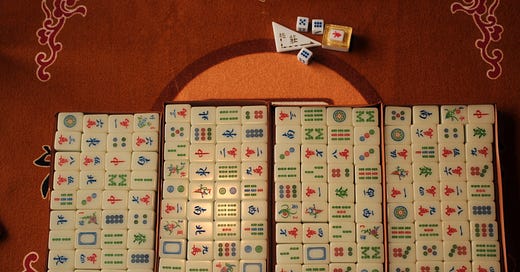




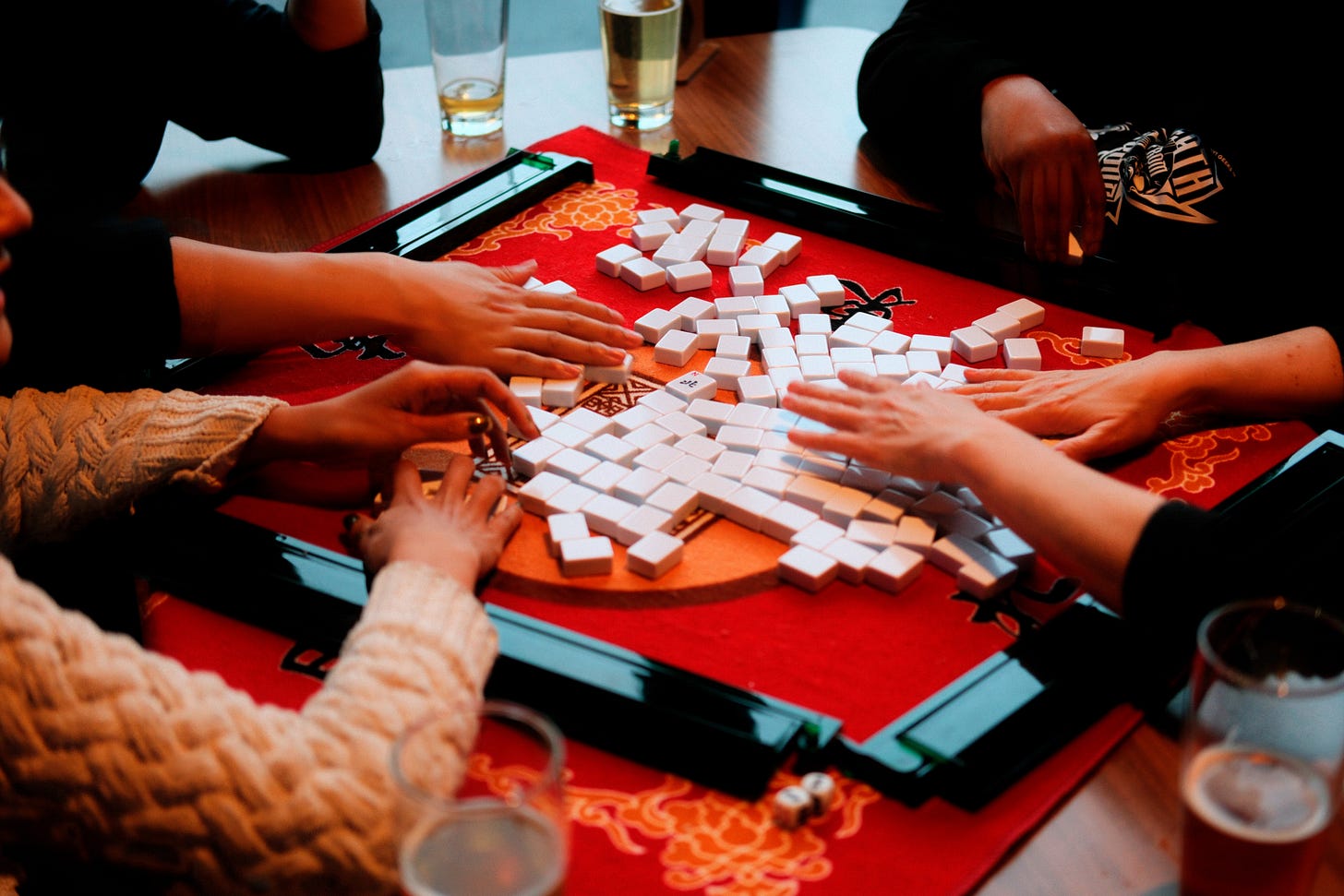
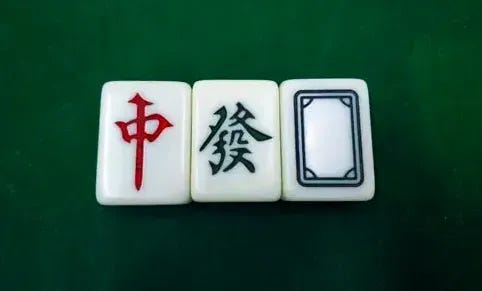
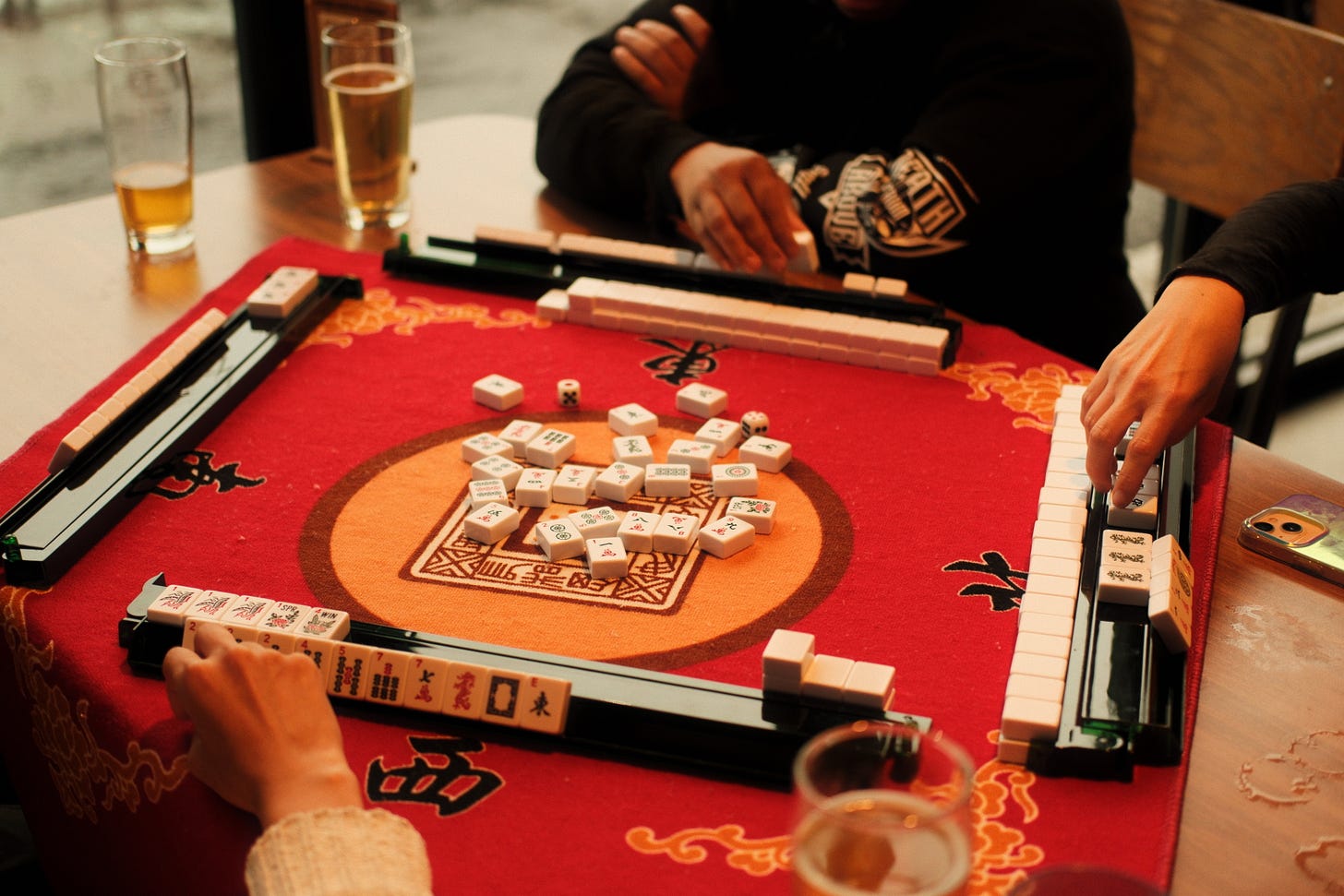
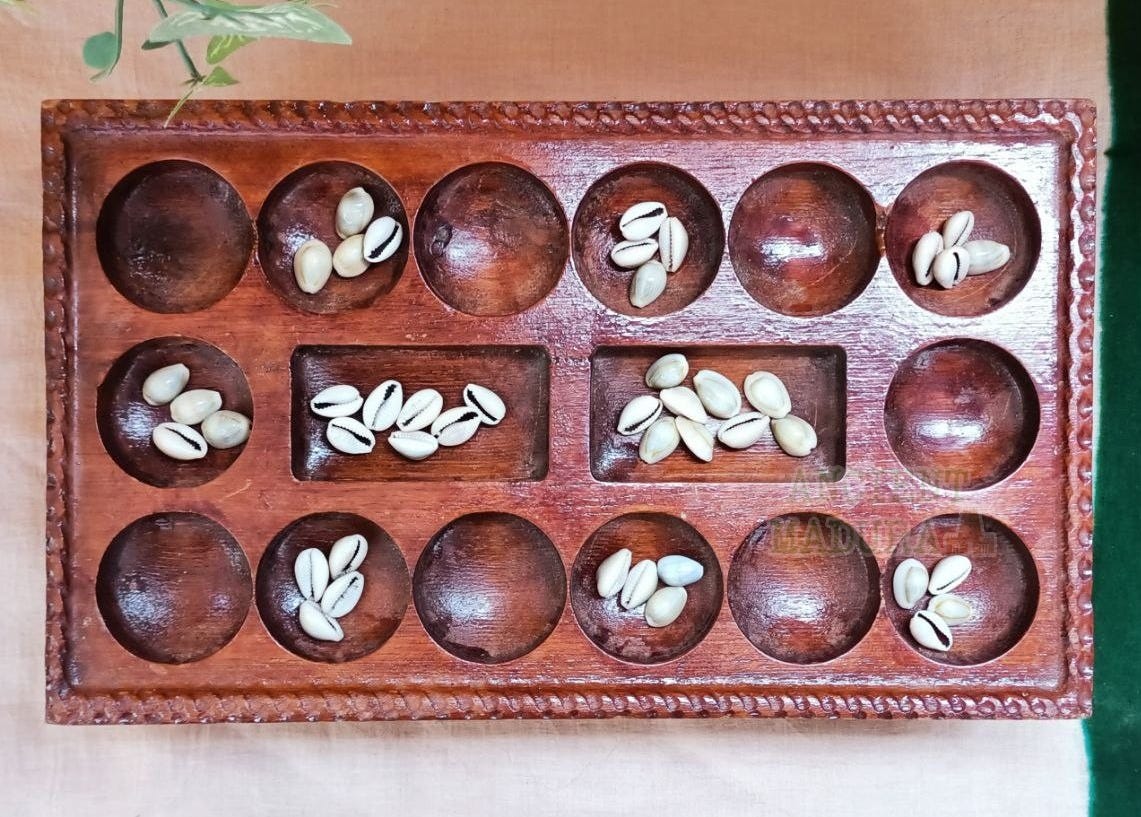
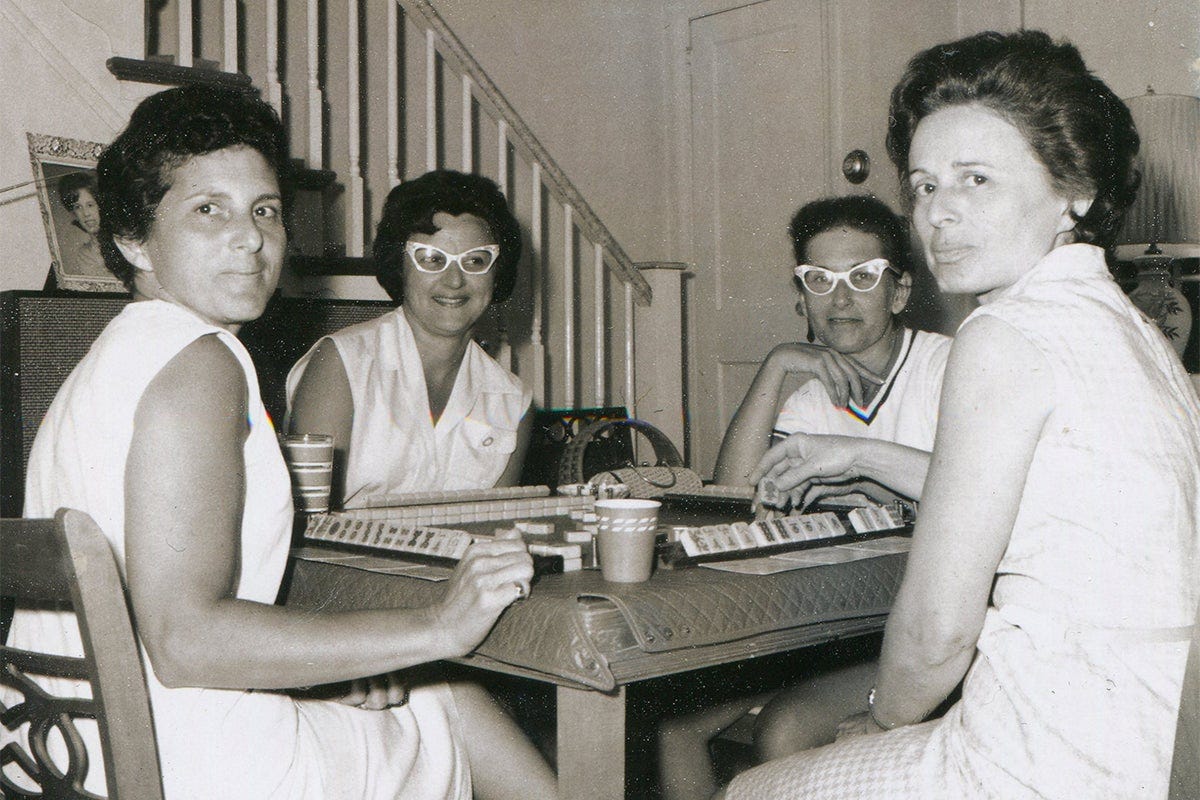
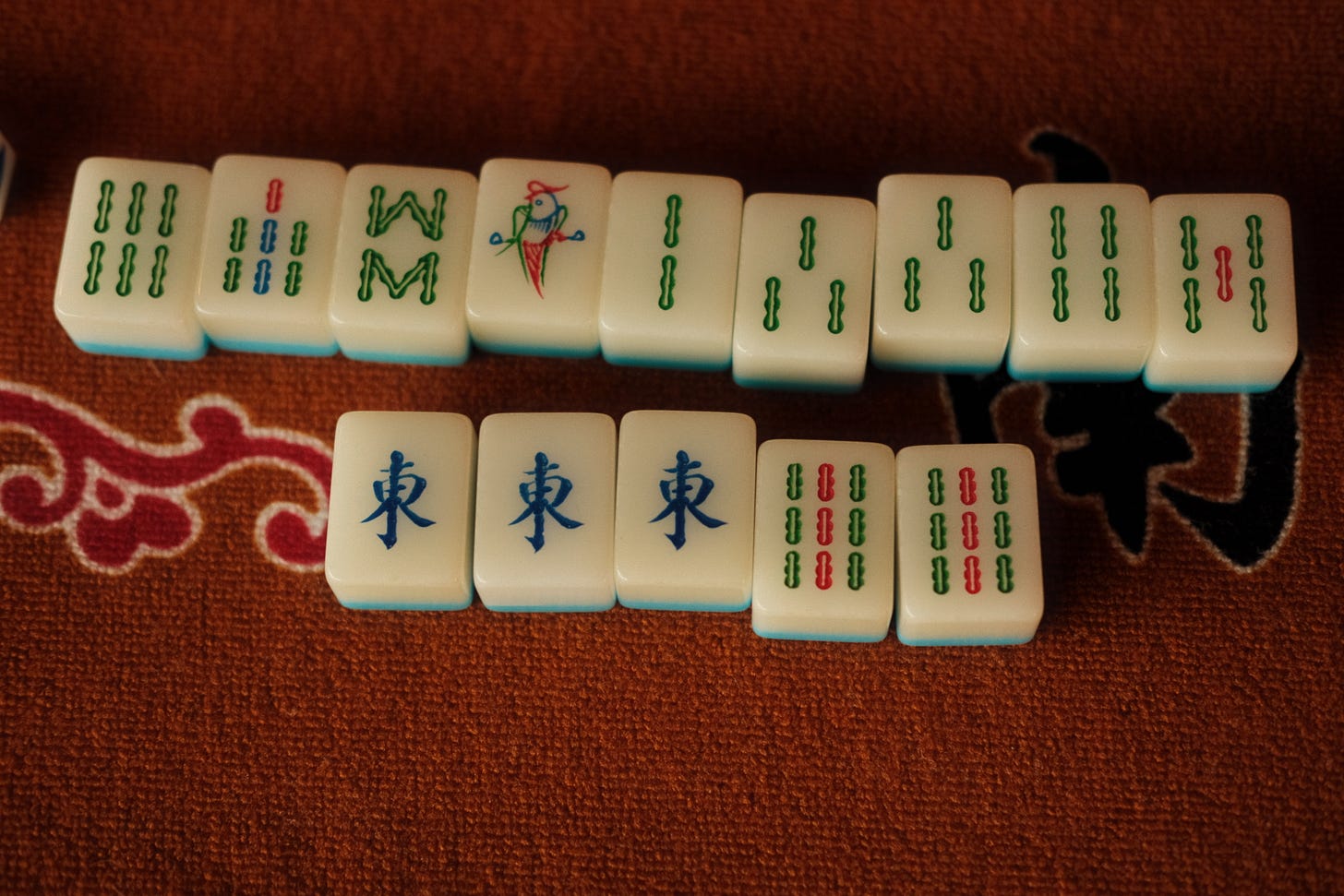
Aaaaaaah!!! Amazing